Regulating Terahertz Photoconductivity in Two-Dimensional Materials
Abstract
1. Introduction
2. THz Experimental Setup and THz Data Analysis
3. Regulating THz PC in 2D Materials by Gas Absorption
3.1. THz PC Regulation in Graphene by Gas Absorption
3.2. THz PC Regulation in TMDs Using Gas Absorption
4. Regulating THz PC in 2D Materials with Electrostatic Gating
4.1. Regulating THz PC of Graphene with Electrostatic Gating
4.2. THz PC of Gr/TMD Heterostructures Regulated Using a Substrate Field
5. Regulating THz PC in Gr/TMD Heterostructures by Photogating
6. Regulating THz PC in TMDs by the Photoinduced Formation of Elementary Excitation
6.1. Regulating THz Photoconductivity via the Formation of Trion in Monolayer MoS2
6.2. Regulating THz Photoconductivity by the Formation of Polarons
7. Conclusions and Perspective
Author Contributions
Funding
Institutional Review Board Statement
Informed Consent Statement
Data Availability Statement
Conflicts of Interest
References
- Novoselov, K.S.; Geim, A.K.; Morozov, S.V.; Jiang, D.; Zhang, Y.; Dubonos, S.V.; Grigorieva, I.V.; Firsov, A.A. Electric field effect in atomically thin carbon films. Science 2004, 306, 666. [Google Scholar] [CrossRef]
- Zhou, Y.; Sung, J.; Brutschea, E.; Esterlis, I.; Wang, Y.; Scuri, G.; Gelly, R.J.; Heo, H.; Taniguchi, T.; Watanabe, K.; et al. Bilayer Wigner crystals in a transition metal dichalcogenide heterostructure. Nature 2021, 595, 48. [Google Scholar] [PubMed]
- Wallbank, J.R.; Ghhazaryan, D.; Misra, A.; Cao, Y.; Tu, J.S.; Piot, B.A.; Potemski, M.; Pezzini, S.; Wiiedmann, S.; Zeitler, U.; et al. Tuning the valley and chiral quantum state of Dirac electrons in van der Waals heterostructures. Science 2016, 353, 575. [Google Scholar] [CrossRef] [PubMed]
- Kar, S.; Lake, J.; Adeyemo, S.O.; Santra, T.S.; Joyce, H.J. The physics of terahertz negative photoconductivity in low dimensional materials. Mater. Today Phys. 2022, 23, 100631. [Google Scholar]
- Sun, Z.; Martinez, A.; Wang, F. Optical modulators with 2D layered materials. Nat. Photonics 2016, 10, 227. [Google Scholar]
- Ahn, C.; Cavalleri, A.; Georges, A.; Ismail-Beigi, S.; Millis, A.J.; Triscone, J. Designing and controlling the properties of transition metal oxide quantum materials. Nat. Mater. 2021, 20, 1462. [Google Scholar] [CrossRef]
- Gong, C.; Zhang, X. Two-dimensional magnetic crystals and emergent heterostructure devices. Science 2019, 363, 706. [Google Scholar]
- Trovatello, C.; Marini, A.; Xu, X.; Lee, C.; Liu, F.; Curreli, N.; Manzoni, C.; Conte, S.D.; Yao, K.; Ciattoni, A.; et al. Optical parametric amplification by monolayer transition metal dichalcogenides. Nat. Photonics 2021, 15, 6–10. [Google Scholar] [CrossRef]
- Mahatha, S.K.; Patel, K.D.; Menon, K.S. Electronic structure investigation of MoS2 and MoSe2 using angle-resolved photoemission spectroscopy and ab initio band structure studies. J. Phys. Condens. Matter 2011, 24, 475504. [Google Scholar] [CrossRef] [PubMed]
- Wickramaratne, D.; Weston, L.; Van de Walle, C.G. Monolayer to bulk properties of hexagonal boron nitride. J. Phys. Chem. C 2018, 122, 25524. [Google Scholar] [CrossRef]
- Kara, A.; Enriquez, H.; Seitsonen, A.P.; Voon LL, Y.; Vizzini, S.; Aufray, B.; Oughaddou, H. A review on silicene d new candidate for electronics. Surf. Sci. Rep. 2012, 67, 1–18. [Google Scholar]
- Djire, A.; Zhang, H.; Liu, J.; Miller, E.M.; Neale, N.R. Electrocatalytic and optoelectronic characteristics of the two-dimensional titanium nitride Ti4N3Tx MXene. ACS Appl. Mater. Interfaces 2019, 11, 11812. [Google Scholar] [CrossRef] [PubMed]
- Wu, M.; Zeng, X.C. Intrinsic Ferroelasticity and/or Multiferroicity in Two-Dimensional Phosphorene and Phosphorene Analogues. Nano Lett. 2016, 16, 3236. [Google Scholar] [CrossRef] [PubMed]
- Ranjan, P.; Ranjan, P.; Lee, J.M.; Kumar, P.; Vinu, A. Borophene: New sensation in flatland. Adv. Mater. 2020, 32, 2000531. [Google Scholar] [CrossRef]
- Schwartz, I.; Shimazaki, Y.; Kuhlenkamp, C.; Watanabe, K.; Taniguchi, T.; Kroner, M.; Imamoglu, A. Electrically tunable Feshbach resonances in twisted bilayer semiconductors. Science 2021, 374, 336. [Google Scholar] [CrossRef]
- Liu, L.; Li, T.; Ma, L.; Li, W.; Gao, S.; Sun, W.; Dong, R.; Zou, X.; Fan, D.; Shao, L.; et al. Uniform nucleation and epitaxy of bilayer molybdenum disulfide on sapphire. Nature 2022, 605, 69. [Google Scholar] [CrossRef]
- Yin, Z.; Li, H.; Li, H.; Jiang, L.; Shi, Y.; Sun, Y.; Lu, G.; Zhang, Q.; Chen, X.; Zhang, H. Single-layer MoS2 phototransistors. ACS Nano 2012, 6, 74. [Google Scholar] [CrossRef] [PubMed]
- Choi, W.; Cho, M.Y.; Konar, A.; Lee, J.H.; Cha, G.-B.; Hong, S.C.; Kim, S.; Kim, J.; Jena, D.; Joo, J.; et al. High-detectivity multilayer MoS2 phototransistors with spectral response from ultraviolet to infrared. Adv. Mater. 2012, 24, 5832. [Google Scholar] [CrossRef]
- Tsai, M.L.; Su, S.H.; Chang, J.K.; Tsai, D.S.; Chen, C.H.; Wu, C.I.; Li, L.J.; Chen, L.J.; He, J.H. Monolayer MoS2 heterojunction solar cells. ACS Nano 2014, 8, 8317. [Google Scholar] [CrossRef]
- Wang, C.; Yang, F.; Gao, Y. The highly-efficient light-emitting diodes based on transition metal dichalcogenides: From architecture to performance. Nanoscale Adv. 2020, 2, 4323. [Google Scholar]
- Lopez-Sanchez, O.; Lembke, D.; Kayci, M.; Radenovic, A.; Kis, A. Ultrasensitive photodetectors based on monolayer MoS2. Nat. Nanotechnol. 2013, 8, 497. [Google Scholar] [CrossRef] [PubMed]
- Lembke, D.; Bertolazzi, S.; Kis, A. Single-layer MoS2 electronics. Acc. Chem. Res. 2015, 48, 100. [Google Scholar] [CrossRef]
- Lu, J.; Li, X.; Zhang, Y.; Hwang, H.Y.; Ofori-Okai, B.K.; Nelson, K.A. Two-Dimensional Spectroscopy at Terahertz Frequencies. Multidimensional Time-Resolved Spectroscopy 2018, 275–320. [Google Scholar] [CrossRef]
- Li, G.; Li, D.; Jin, Z.; Ma, G. Photocarriers dynamics in silicon wafer studied with optical-pump terahertz-probe spectroscopy. Opt. Commun. 2012, 285, 4102. [Google Scholar] [CrossRef]
- Li, D.; Li, G.; Kong, H.; Shu, S.; Ma, G.; Ge, J.; Hu, S.; Dai, N. The Extraordinary Transmission Spectrum in Terahertz Regime: Combination of Shape Resonances and Rayleigh anomalies. J. Millim. Infrared THz Waves 2012, 33, 212. [Google Scholar] [CrossRef]
- Li, G.; Jin, Z.; Xue, X.; Lin, X.; Ma, G.; Hu, S.; Dai, N. Terahertz coherent control of surface plasmon polariton propagation in subwavelength metallic hole arrays. Appl. Phys. Lett. 2012, 100, 191115. [Google Scholar] [CrossRef]
- Xue, X.; Jiang, M.; Li, G.; Lin, X.; Ma, G.; Jin, P. Photoinduced Insulator-Metal Phase Transition and the Metallic Phase Propagation in VO2 Films Investigated by Time-Resolved Terahertz Spectroscopy. J. Appl. Phys. 2013, 114, 193506. [Google Scholar] [CrossRef]
- Zhang, W.; Yang, Y.; Suo, P.; Zhao, W.; Guo, J.; Lu, Q.; Lin, X.; Jin, Z.; Wang, L.; Chen, G.; et al. Ultrafast photocarrier dynamics in a 3D Dirac semimetal Cd3As2 film studied with terahertz spectroscopy. Appl. Phys. Lett. 2019, 114, 221102. [Google Scholar] [CrossRef]
- Zhang, W.; Guo, J.; Suo, P.; Lv, L.; Liu, J.; Lin, X.; Jin, Z.; Liu, W.; Ma, G. Optically Controlled Ultrafast Terahertz Switching in CdTe Nanostructure Thin Film. Appl. Opt. 2019, 58, 308200. [Google Scholar] [CrossRef]
- Kittel, C. Introduction to Solid State Physics, 7th ed.; John Wiley & Sons Ltd.: Hoboken, NJ, USA, 1996. [Google Scholar]
- Ulbricht, R.; Hendry, E.; Shan, J.; Heinz, T.F.; Bonn, M. Carrier dynamics in semiconductors studied with time-resolved terahertz spectroscopy. Rev. Mod. Phys. 2011, 83, 543. [Google Scholar]
- Shimakawa, K.; Itoh, T.; Naito, H.; Kasap, S.O. The origin of non-Drude terahertz conductivity in nanomaterials. Appl. Phys. Lett. 2012, 100, 132102. [Google Scholar] [CrossRef]
- Zhang, Y.; Tang, T.-T.; Girit, C.; Hao, Z.; Martin, M.C.; Zettl, A.; Crommie, M.F.; Shen, Y.R.; Wang, F. Direct observation of a widely tunable bandgap in bilayer graphene. Nature 2009, 459, 820. [Google Scholar] [CrossRef] [PubMed]
- George, P.A.; Strait, J.; Dawlaty, J.; Shivaraman, S.; Chandrashekhar, M.; Rana, F.; Spencer, M.G. Ultrafast optical-pump terahertz-probe spectroscopy of the carrier relaxation and recombination dynamics in epitaxial graphene. Nano Lett. 2008, 8, 4248–4251. [Google Scholar] [CrossRef] [PubMed]
- Bahk, Y.M.; Ramakrishnan, G.; Choi, J.; Song, H.; Choi, G.; Kim, Y.H.; Ahn, K.J.; Kim, D.S.; Planken, P.C.M. Plasmon enhanced terahertz emission from single layer graphene. ACS Nano 2014, 8, 9089–9096. [Google Scholar] [CrossRef]
- Ivanov, I.; Bonn, M.; Mics, Z.; Turchinovich, D. Perspective on terahertz spectroscopy of graphene. Europhys. Lett. 2015, 111, 67001. [Google Scholar] [CrossRef]
- Docherty, C.J.; Lin, C.T.; Joyce, H.J.; Nicholas, R.J.; Herz, L.M.; Li, L.J.; Johnston, M.B. Extreme sensitivity of graphene photoconductivity to environmental gases. Nat. Commun. 2015, 3, 1228. [Google Scholar] [CrossRef] [PubMed]
- Zhang, Z.; Lin, T.; Xing, X.; Lin, X.; Meng, X.; Cheng, Z.; Jin, Z.; Ma, G. Photoexcited terahertz conductivity dynamics of graphene tuned by oxygen-adsorption. Appl. Phys. Lett. 2017, 110, 111108. [Google Scholar] [CrossRef]
- Hafez, H.A.; Chai, X.; Sekine, Y.; Takamura, M.; Oguri, K.; Al-Naib, I.; Dignam, M.M.; Hibino, H.; Ozaki, T. Effects of environmental conditions on the ultrafast carrier dynamics in graphene revealed by terahertz spectroscopy. Phys. Rev. B 2017, 95, 165428. [Google Scholar] [CrossRef]
- Mics, Z.; Tielrooij, K.J.; Parvez, K.; Jensen, S.A.; Ivanov, I.; Feng, X.; Müllen, K.; Bonn, M.; Turchinovich, D. Thermodynamic picture of ultrafast charge transport in graphene. Nat. Commun. 2015, 6, 7655. [Google Scholar] [CrossRef]
- Jia, T.; Zhang, W.; Zhang, Z.; Zhan, Z.; Ma, G.; Du, J.; Leng, Y. Role of the Optical Acoustic Phonon Interaction in the Ultrafast Cooling Process of CVD Graphene. J. Phys. Chem. C 2021, 125, 27283. [Google Scholar] [CrossRef]
- Wu, J.; Yue, G.; Chen, W.; Xing, Z.; Wang, J.; Wong, W.R.; Cheng, Z.; Set, S.Y.; Senthil Murugan, G.; Wang, X.; et al. On-Chip Optical Gas Sensors Based on Group-IV Materials. ACS Photonics 2020, 7, 2923. [Google Scholar] [CrossRef]
- Di Bartolomeo, A.; Genovese, L.; Giubileo, F.; Iemmo, L.; Luongo, G.; Foller, T.; Schleberger, M. Hysteresis in the transfer characteristics of MoS2 transistors 2D Materials. 2D Mater. 2017, 5, 015014. [Google Scholar] [CrossRef]
- Lin, Z.; McCreary, A.; Briggs, N.; Subramanian, S.; Zhang, K.; Sun, Y.; Li, X.; Borys, N.J.; Yuan, H.; Fullerton-Shirey, S.K. 2D materials advances: From large scale synthesis and controlled heterostructures to improved characterization techniques, defects and applications. 2D Mater. 2016, 3, 042001. [Google Scholar] [CrossRef]
- Yoon, Y.; Ganapathi, K.; Salahuddin, S. How Good Can Monolayer MoS2 Transistors Be? Nano Lett. 2011, 11, 3768. [Google Scholar] [CrossRef] [PubMed]
- Late, D.J.; Shaikh, P.A.; Khare, R.; Kashid, R.V.; Chaudhary, M.; More, M.A.; Ogale, S.B. Pulsed Laser-Deposited MoS2 Thin Films on W and Si: Field Emission and Photoresponse Studies. ACS Appl. Mater. Interfaces 2014, 6, 15881. [Google Scholar] [CrossRef]
- Sun, K.; Ma, H.; Xia, W.; Suo, P.; Zhang, W.; Zou, Y.; Lin, X.; Zhang, S.; Guo, Y.; Ma, G. Dynamical Response of Nonlinear Optical Anisotropy in a Tin Sulfide Crystal under Ultrafast Photoexcitation. J. Phys. Chem. Lett. 2022, 13, 9355–9362. [Google Scholar] [CrossRef]
- Peimyoo, N.; Yang, W.; Shang, J.; Shen, X.; Wang, Y.; Yu, T. Chemically Driven Tunable Light Emission of Charged and Neutral Excitons in Monolayer WS2. ACS Nano 2014, 8, 11320. [Google Scholar] [CrossRef]
- Kobayashi, Y.; Sasaki, S.; Mori, S.; Hibino, H.; Liu, Z.; Watanabe, K.; Taniguchi, T.; Suenaga, K.; Maniwa, Y.; Miyata, Y. Growth and Optical Properties of High-Quality Monolayer WS2 on Graphite. ACS Nano 2015, 9, 4056. [Google Scholar] [CrossRef]
- Raja, A.; Chaves, A.; Yu, J.; Arefe, G.; Hill, H.M.; Rigosi, A.F.; Berkelbach, T.C.; Nagler, P.; Schüller, C.; Korn, T.; et al. Coulomb engineering of the bandgap and excitons in two-dimensional materials. Nat. Commun. 2017, 8, 15251. [Google Scholar] [CrossRef]
- Krasnok, A.; Lepeshov, S.; Alú, A. Nanophotonics with 2D transition metal dichalcogenides. Opt. Express 2018, 26, 15972. [Google Scholar] [CrossRef]
- Urban, F.; Martucciello, N.; Peters, L.; McEvoy, N.; Bartolomeo, A.D. Environmental Effects on the Electrical Characteristics of Back-Gated WSe2 Field-Effect Transistors. Nanomaterials 2018, 8, 901. [Google Scholar] [CrossRef] [PubMed]
- Bartolomeo, A.D.; Pelella, A.; Liu, X.; Miao, F.; Passacantando, M.; Giubileo, F.; Grillo, A.; Iemmo, L.; Urban, F.; Liang, S.J. Pressure-Tunable Ambipolar Conduction and Hysteresis in Thin Palladium Diselenide Field Effect Transistors. Adv. Funct. Mater. 2019, 29, 1902483. [Google Scholar] [CrossRef]
- Li, H.; Yin, Z.; He, Q.; Li, H.; Huang, X.; Lu, G.; Fam, D.W.H.; Tok, A.I.Y.; Zhang, Q.; Zhang, H. Fabrication of Single- and Multilayer MoS2 Film-Based Field-Effect Transistors for Sensing NO at Room Temperature. Small 2012, 8, 63. [Google Scholar] [CrossRef] [PubMed]
- Urban, F.; Giubileo, F.; Grillo, A.; Iemmo, L.; Luongo, G.; Passacantando, M.; Foller, T.; Madauß, L.; Pollmann, E.; Geller, M.P.; et al. Gas dependent hysteresis in MoS2 field effect transistors. 2D Mater. 2019, 6, 045049. [Google Scholar] [CrossRef]
- Park, W.; Park, J.; Jang, J.; Lee, H.; Jeong, H.; Cho, K.; Hong, S.; Lee, T. Oxygen environmental and passivation effects on molybdenum disulfide field effect transistors. Nanotechnology 2013, 24, 095202. [Google Scholar] [CrossRef]
- Qiu, H.; Pan, L.; Yao, Z.; Li, J.; Shi, Y.; Wang, X. Electrical characterization of back-gated bi-layer MoS2 field-effect transistors and the effect of ambient on their performances. Appl. Phys. Lett. 2012, 100, 123104. [Google Scholar] [CrossRef]
- Grillo, A.; Faella, E.; Pelella, A.; Giubileo, F.; Ansari, L.; Gity, F.; Hurley, P.K.; McEvoy, N.; Bartolomeo, A.D. Coexistence of Negative and Positive Photoconductivity in Few-Layer PtSe2 Field-Effect Transistors. Adv. Funct. Mater. 2021, 31, 2105722. [Google Scholar] [CrossRef]
- Lee, Y.-H.; Zhang, X.-Q.; Zhang, W.; Chang, M.-T.; Lin, C.-T.; Chang, K.-D.; Yu, Y.-C.; Wang, J.T.-W.; Chang, C.-S.; Li, L.-J.; et al. Synthesis of Large-Area MoS2 Atomic Layers with Chemical Vapor Deposition. Adv. Mater. 2012, 24, 2320. [Google Scholar] [CrossRef]
- Zhang, W.; Huang, J.-K.; Chen, C.-H.; Chang, Y.-H.; Cheng, Y.-J.; Li, L.-J. High-Gain Phototransistors Based on a CVD MoS2 Monolayer. Adv. Mater. 2013, 25, 3456. [Google Scholar] [CrossRef]
- Hornett, S.M.; Heath, M.; Horsell, D.W.; Hendry, E. Optically induced oxygen desorption from graphene measured using femtosecond two-pulse correlation. Phys. Rev. B 2014, 90, 081401. [Google Scholar] [CrossRef]
- Wang, H.I.; Braatz, M.-L.; Richter, N.; Tielrooij, K.-J.; Mics, Z.; Lu, H.; Weber, N.-E.; Müllen, K.; Turchinovich, D.; Kläui, M.; et al. Reversible Photochemical Control of Doping Levels in Supported Graphene. J. Phys. Chem. C 2017, 121, 4083. [Google Scholar] [CrossRef]
- Tongay, S.; Suh, J.; Ataca, C.; Fan, W.; Luce, A.; Kang, J.S.; Liu, J.; Ko, C.; Raghunathanan, R.; Zhou, J.; et al. Defects activated photoluminescence in two-dimensional semiconductors: Interplay between bound; charged and free excitons. Sci. Rep. 2013, 3, 2657. [Google Scholar] [CrossRef] [PubMed]
- Tongay, S.; Zhou, J.; Ataca, C.; Liu, J.; Kang, J.S.; Matthews, T.S.; You, L.; Li, J.; Grossman, J.C.; Wu, J. Broad-Range Modulation of Light Emission in Two-Dimensional Semiconductors by Molecular Physisorption Gating. Nano Lett. 2013, 13, 2831. [Google Scholar] [CrossRef] [PubMed]
- Nan, H.; Wang, Z.; Wang, W.; Liang, Z.; Lu, Y.; Chen, Q.; He, D.; Tan, P.; Miao, F.; Wang, X.; et al. Strong Photoluminescence Enhancement of MoS2 through Defect Engineering and Oxygen Bonding. ACS Nano 2014, 8, 5738. [Google Scholar] [CrossRef] [PubMed]
- Gogoi, P.K.; Hu, Z.; Wang, Q.; Carvalho, A.; Schmidt, D.; Yin, X.; Chang, Y.-H.; Li, L.-J.; Sow, C.H.; Neto, A.H.C.; et al. Oxygen Passivation Mediated Tunability of Trion and Excitons in MoS2. Phys. Rev. Lett. 2017, 119, 077402. [Google Scholar] [CrossRef]
- Xing, X.; Zhao, L.; Zhang, Z.; Lin, X.; Yu, Y.; Jin, Z.; Liu, W.; Zhang, W.; Ma, G. The modulation of terahertz photoconductivity in CVD grown n-doped monolayer MoS2 with gas adsorption. J. Phys. Condens. Matter 2019, 31, 245001. [Google Scholar] [CrossRef]
- Kim, J.H.; Lee, J.; Kim, J.H.; Hwang, C.C.; Lee, C.; Park, J.Y. Work function variation of MoS2 atomic layers grown with chemical vapor deposition: The effects of thickness and the adsorption of water/oxygen molecules. Appl. Phys. Lett. 2015, 106, 251606. [Google Scholar] [CrossRef]
- Late, D.J.; Liu, B.; Matte, H.S.S.R.; Dravid, V.P.; Rao, C.N.R. Hysteresis in Single-Layer MoS2 Field Effect Transistors. ACS Nano 2012, 6, 5635. [Google Scholar] [CrossRef]
- Gustafson, J.K.; Wines, D.; Gulian, E.; Ataca, C.; Hayden, L.M. Positive and Negative Photoconductivity in Monolayer MoS2 as a Function of Physisorbed Oxygen. J. Phys. Chem. C 2021, 125, 8712. [Google Scholar] [CrossRef]
- Mak, K.F.; Mak, K.F.; Sfeir, M.Y.; Wu, Y.; Lui, C.H.; Misewich, J.A.; Heinz, T.F. Measurement of the Optical Conductivity of Graphene. Phys. Rev. Lett. 2008, 101, 196405. [Google Scholar] [CrossRef]
- Wang, F.; Zhang, Y.B.; Tian, C.S.; Girit, C.; Zettl, A.; Crommie, M.; Shen, Y.R. Gate-variable optical transitions in graphene. Science 2008, 320, 208. [Google Scholar] [CrossRef] [PubMed]
- Choi, H.; Borondics, F.; Siegel, D.A.; Zhou, S.Y.; Martin, M.C.; Lanzara, A.; Kaindl, R.A. Broadband electromagnetic response and ultrafast dynamics of few-layer epitaxial graphene. Appl. Phys. Lett. 2009, 94, 172104. [Google Scholar] [CrossRef]
- Tielrooij, K.J.; Song, J.C.W.; Jensen, S.A.; Centeno, A.; Pesquera, A.; Elorza, A.Z.; Bonn, M.; Levitov, L.S.; Koppens, F.H.L. Photoexcitation cascade and multiple hot-carrier generation in graphene. Nat. Phys. 2013, 9, 248. [Google Scholar] [CrossRef]
- Hattab, H.; N’Diaye, A.; Wall, D.; Klein, C.; Jnawali, G.; Coraux, J.; Busse, C.; van Gastel, R.; Poelsema, B.; Michely, T.; et al. Interplay of Wrinkles, Strain, and Lattice Parameter in Graphene on Iridium. Nano Lett. 2012, 3, 1228. [Google Scholar] [CrossRef] [PubMed]
- Frenzel, A.J.; Lui, C.H.; Fang, W.; Nair, N.L.; Herring, P.K.; Jarillo-Herrero, P.; Kong, J.; Gedik, N. Observation of suppressed terahertz absorption in photoexcited graphene. Appl. Phys. Lett. 2013, 102, 113111. [Google Scholar] [CrossRef]
- Svintsov, D.; Otsuji, T.; Mitin, V.; Shur, M.S.; Ryzhii, V. Negative terahertz conductivity in disordered graphene bilayers with population inversion. Appl. Phys. Lett. 2015, 106, 113501. [Google Scholar] [CrossRef]
- Frenzel, A.J.; Lui, C.H.; Shin, Y.C.; Kong, J.; Gedik, N. Semiconducting-to-metallic Photoconductivity Crossover and Temperature-Dependent Drude Weight in Graphene. Phys. Rev. Lett. 2014, 113, 056602. [Google Scholar] [CrossRef]
- Shi, S.F.; Tang, T.T.; Zeng, B.; Ju, L.; Zhou, Q.; Zettl, A.; Wang, F. Controlling Graphene Ultrafast Hot carrier Response from Metal-like to Semiconductor-like by Electrostaic Gating. Nano Lett. 2014, 14, 1578. [Google Scholar] [CrossRef]
- Tomadin, A.; Hornett, S.M.; Wang, H.I.; Alexeev, E.M.; Candini, A.; Coletti, C.; Turchinovich, D.; Klaui, M.; Bonn, M.; Koppens, F.H.L.; et al. The ultrafast dynamics and conductivity of photoexcited graphene at different Fermi energies. Sci. Adv. 2018, 4, eear5313. [Google Scholar] [CrossRef]
- Cowley, A.M.; Sze, S.M. Surface States and Barrier Height of Metal-Semiconductor Systems. J. Appl. Phys. 1965, 36, 3212. [Google Scholar] [CrossRef]
- Tung, R.T. The physics and chemistry of the Schottky barrier height. Appl. Phys. Rev. 2014, 1, 011304. [Google Scholar] [CrossRef]
- Sun, D.; Aivazian, G.; Jones, A.M.; Ross, J.S.; Yao, W.; Cobden, D.; Xu, X.D. Ultrafast hot-carrier-dominated photocurrent in graphene. Nat. Nanotechnol. 2012, 7, 114. [Google Scholar] [CrossRef]
- Fiori, G.; Bonaccorso, F.; Iannaccone, G.; Palacios, T.; Neumaier, D.; Seabaugh, A.; Banerjee, S.K.; Colombo, L. Electronics based on two-dimensional materials. Nat. Nanotechnol. 2014, 9, 768. [Google Scholar] [CrossRef] [PubMed]
- Liu, Y.; Guo, J.; Zhu, E.B.; Liao, L.; Lee, S.J.; Ding, M.; Shakir, I.; Gambin, V.; Huang, Y.; Duan, X.F. Approaching the Schottky-Mott limit in van der Waals metal-semiconductor junctions. Nature 2018, 557, 696. [Google Scholar] [CrossRef] [PubMed]
- Vu, Q.A.; Shin, Y.S.; Kim, Y.R.; Nguyen, V.L.; Kang, W.T.; Kim, H.; Luong, D.H.; Lee, I.M.; Lee, K.; Ko, D.S.; et al. Two-terminal floating-gate memory with van der Waals heterostructures for ultrahigh on/off ratio. Nat. Commun. 2016, 7, 12725. [Google Scholar] [CrossRef]
- Novoselov, K.S.; Fal’Ko, V.I.; Colombo, L.; Gellert, P.R.; Schwab, M.G.; Kim, K.A. roadmap for graphene. Nature 2012, 490, 192. [Google Scholar] [CrossRef]
- Geim, A.K.; Novoselov, K.S. The rise of graphene. Nat. Mater. 2007, 6, 183. [Google Scholar] [CrossRef]
- Novoselov, K.S.; Geim, A.K.; Morozov, S.V.; Jiang, D.; Katsnelson, M.I.; Grigorieva, I.V.; Dubonos, S.V.; Firsov, A.A. Two-dimensional gas of massless Dirac fermions in graphene. Nature 2009, 438, 197. [Google Scholar] [CrossRef]
- Castro Neto, A.H.; Guinea, F.; Peres, N.M.R.; Novoselov, K.S.; Geim, A.K. The electronic properties of graphene. Rev. Mod. Phys. 2009, 81, 109. [Google Scholar] [CrossRef]
- Yu, W.J.; Li, Z.; Zhou, H.L.; Chen, Y.; Wang, Y.; Huang, Y.; Duan, X.F. Vertically stacked multi-heterostructures of layered materials for logic transistors and complementary inverters. Nat. Mater. 2013, 12, 246. [Google Scholar] [CrossRef]
- Sup Choi, M.; Lee, G.H.; Yu, Y.J.; Lee, D.Y.; Lee, S.H.; Kim, P.; Hone, J.; Yoo, W.J. Controlled charge trapping by molybdenum disulphide and graphene in ultrathin heterostructured memory devices. Nat. Commun. 2013, 4, 1624. [Google Scholar] [CrossRef] [PubMed]
- Zheng, J.; Li, E.L.; Ma, D.M.; Cui, Z.; Peng, T.; Wang, X.L. Effect on Schottky Barrier of Graphene/WS2 Heterostructure with Vertical Electric Field and Biaxial Strain. Phys. Status Solidi (b) 2019, 256, 1900161. [Google Scholar] [CrossRef]
- Yu, Z.G.; Zhang, Y.W.; Yakobson, B.I. Strain-Robust and Electric Field Tunable Band Alignments in van der Waals WSe2–Graphene Heterojunctions. J. Phys. Chem. C 2016, 120, 22702. [Google Scholar] [CrossRef]
- Sun, M.; Chou, J.P.; Yu, J.; Tang, W.C. Effects of structural imperfection on the electronic properties of graphene/WSe2 heterostructures. J. Mater. Chem. C 2017, 5, 10383. [Google Scholar] [CrossRef]
- Zhang, W.; Chuu, C.P.; Huang, J.K.; Chen, C.H.; Tsai, M.L.; Chang, Y.H.; Liang, C.T.; Chen, Y.Z.; Chueh, Y.L.; He, J.H. Ultrahigh-Gain Photodetectors Based on Atomically Thin Graphene-MoS2 Heterostructures. Sci. Rep. 2014, 4, 3826. [Google Scholar] [CrossRef]
- Zhang, L.; Chen, Z.F.; Zhang, R.; Tan, Y.; Wu, T.; Shalaby, M.; Xie, R.; Xu, J.B. Direct Observation of Charge Injection of Graphene in the Graphene/WSe2 Heterostructure by Optical-Pump Terahertz-Probe Spectroscopy. ACS Appl. Mater. Interfaces 2019, 11, 47501. [Google Scholar] [CrossRef] [PubMed]
- Chen, Y.; Li, Y.J.; Zhao, Y.D.; Zhou, H.Z.; Zhu, H.M. Highly efficient hot electron harvesting from graphene before electron-hole thermalization. Sci. Adv. 2019, 5, eaax9958. [Google Scholar] [CrossRef]
- Froehlicher, G.E.; Lorchat, E.; Berciaud, S. Charge Versus Energy Transfer in Atomically Thin Graphene-Transition Metal Dichalcogenide van der Waals Heterostructures. Phys. Rev. X 2018, 8, 011007. [Google Scholar] [CrossRef]
- Larentis, S.; Tolsma, J.R.; Fallahazad, B.; Dillen, D.C.; Kim, K.; MacDonald, A.H.; Tutuc, E. Band Offset and Negative Compressibility in Graphene-MoS2 Heterostructures. Nano Lett. 2014, 14, 2039. [Google Scholar] [CrossRef]
- Xing, X.; Zhang, Z.Y.; Quan, C.J.; Zhao, L.T.; Wang, C.W.; Jia, T.Y.; Ren, J.F.; Du, J.; Leng, Y.X. Tunable ultrafast electron transfer in WSe2–graphene heterostructures enabled by atomic stacking order. Nanoscale 2022, 14, 7418. [Google Scholar] [CrossRef]
- Ma, Q.S.; Zhang, W.J.; Wang, C.W.; Pu, R.H.; Ju, C.W.; Lin, X.; Zhang, Z.Y.; Liu, W.M.; Li, R.X. Hot Carrier Transfer in a Graphene/PtSe2 Heterostructure Tuned by a Substrate-Introduced Effective Electric Field. J. Phys. Chem. C 2021, 125, 9296. [Google Scholar] [CrossRef]
- Xing, X.; Zhao, L.T.; Zhang, W.J.; Wang, Z.; Su, H.M.; Chen, H.Y.; Ma, G.H.; Dai, J.F.; Zhang, W.J. Influence of a substrate on ultrafast interfacial charge transfer and dynamical interlayer excitons in monolayer WSe2/graphene heterostructures. Nanoscale 2020, 12, 2498. [Google Scholar] [CrossRef] [PubMed]
- Fu, S.; du Fosse, I.; Jia, X.Y.; Xu, J.Y.; Yu, X.Q.; Zhang, H.; Zheng, W.H.; Krasel, S.; Chen, Z.P.; Wang, Z.M.M.; et al. Long-lived charge separation following pump-wavelength-dependent ultrafast charge transfer in graphene/WS2 heterostructures. Sci. Adv. 2021, 7, eabd9061. [Google Scholar] [CrossRef] [PubMed]
- Quan, C.; Xing, X.; Jia, T.; Zhang, Z.; Wang, C.; Huang, S.; Liu, Z.; Du, J.; Leng, Y. Hot Carrier Transfer in PtSe2/Graphene Enabled by the Hot Phonon Bottleneck. J. Phys. Chem. Lett. 2022, 13, 9456–9463. [Google Scholar] [CrossRef]
- Zou, Y.; Ma, Q.S.; Zhang, Z.; Pu, R.; Zhang, W.; Suo, P.; Sun, K.; Chen, J.; Li, D.; Ma, H. Observation of Ultrafast Interfacial Exciton Formation and Relaxation in Graphene/MoS2 Heterostructure. J. Phys. Chem. Lett. 2022, 13, 5123–5130. [Google Scholar] [CrossRef]
- Kim, H.J.; Lee, K.J.; Park, J.; Shin, G.H.; Park, H.; Yu, K.; Choi, S.Y. Photoconductivity switching in MoTe2/graphene heterostructure by trap-assisted photogating. ACS Appl. Mater. Interfaces 2020, 12, 38563–38569. [Google Scholar] [CrossRef]
- Qiu, D.Y.; Da Jornada, F.H.; Louie, S.G. Optical spectrum of MoS2: Many-body effects and diversity of exciton states. Phys. Rev. Lett. 2013, 111, 216805. [Google Scholar] [CrossRef]
- He, K.; Kumar, N.; Zhao, L.; Wang, Z.; Mak, K.F.; Zhao, H.; Shan, J. Tightly bound excitons in monolayer WSe2. Phys. Rev. Lett. 2014, 113, 026803. [Google Scholar] [CrossRef]
- Chernikov, A.; Berkelbach, T.C.; Hill, H.M.; Rigosi, A.; Li, Y.; Aslan, B.; Reichman, D.R.; Hybertsen, M.S.; Heinz, T.F. Exciton binding energy and nonhydrogenic Rydberg series in monolayer WS2. Phys. Rev. Lett. 2014, 113, 076802. [Google Scholar] [CrossRef]
- Singh, A.; Moody, G.; Wu, S.; Wu, Y.; Ghimire, N.J.; Yan, J.; Mandrus, D.G.; Xu, X.; Li, X. Coherent electronic coupling in atomically thin MoSe2. Phys. Rev. Lett. 2014, 112, 216804. [Google Scholar] [CrossRef]
- Hichri, A.; Amara, I.B.; Ayari, S.; Jaziri, S. Dielectric environment and/or random disorder effects on free, charged and localized excitonic states in monolayer WS2. J. Phys. Condens. Matter. 2017, 29, 435305. [Google Scholar] [CrossRef]
- Tu, J.S.; Borghardt, S.; Grützmacher, D.; Kardynał, B.E. Experimental observation of a negative grey trion in an electron-rich WSe2 monolayer. J. Phys. Condens. Matter. 2019, 31, 415701. [Google Scholar] [CrossRef] [PubMed]
- Lui, C.; Frenzel, A.; Pilon, D.; Lee, Y.H.; Ling, X.; Akselrod, G.; Kong, J.; Gedik, N. Trion-induced negative photoconductivity in monolayer MoS2. Phys. Rev. Lett. 2014, 113, 166801. [Google Scholar] [CrossRef] [PubMed]
- Suo, P.; Zhang, H.; Yan, S.; Zhang, W.; Fu, J.; Lin, X.; Hao, S.; Jin, Z.; Zhang, Y.; Zhang, C. Observation of negative terahertz photoconductivity in large area type-II Dirac semimetal PtTe2. Phys. Rev. Lett. 2021, 126, 227402. [Google Scholar] [CrossRef]
- Ishida, Y.; Masuda, H.; Sakai, H.; Ishiwata, S.; Shin, S. Revealing the ultrafast light-to-matter energy conversion before heat diffusion in a layered Dirac semimetal. Phys. Rev. B 2016, 93, 100302. [Google Scholar] [CrossRef]
- Baek, E.; Rim, T.; Schütt, J.; Baek, C.K.; Kim, K.; Baraban, L.; Cuniberti, G. Negative photoconductance in heavily doped Si nanowire field-effect transistors. Nano Lett. 2017, 17, 6727–6734. [Google Scholar] [CrossRef] [PubMed]
- Yang, Y.; Peng, X.; Hyatt, S.; Yu, D. Broadband quantum efficiency enhancement in high index nanowire resonators. Nano Lett. 2015, 15, 3541–3546. [Google Scholar] [CrossRef]
- Anemone, G.; Garnica, M.; Zappia, M.; Aguilar, P.C.; Al Taleb, A.; Kuo, C.N.; Lue, C.S.; Politano, A.; Benedek, G.; De Parga, A.L.V. Experimental determination of surface thermal expansion and electron–phonon coupling constant of 1T-PtTe2. 2D Mater. 2020, 7, 025007. [Google Scholar] [CrossRef]
- Chen, J.; Suo, P.; Zhang, W.; Ma, H.; Fu, J.; Li, D.; Lin, X.; Yan, X.; Liu, W.; Jin, Z. Photocarrier-Driven Emergence of Negative Photoconductivity in Semimetal MoTe2 Films Revealed with Terahertz Spectroscopy. J. Phys. Chem. C 2022, 126, 9407–9415. [Google Scholar] [CrossRef]
- Kim, H.J.; Kang, S.H.; Hamada, I.; Son, Y.W. Origins of the structural phase transitions in MoTe2 and WTe2. Phys. Rev. B 2017, 95, 180101. [Google Scholar] [CrossRef]
- Cheon, Y.; Lim, S.Y.; Kim, K.; Cheong, H. Structural phase transition and interlayer coupling in few-layer 1T′ and Td MoTe2. ACS Nano 2021, 15, 2962–2970. [Google Scholar] [CrossRef] [PubMed]
- Zhu, H.; Miyata, K.; Fu, Y.; Wang, J.; Joshi, P.P.; Niesner, D.; Williams, K.W.; Jin, S.; Zhu, X.Y. Screening in crystalline liquids protects energetic carriers in hybrid perovskites. Science 2016, 353, 1409–1413. [Google Scholar] [CrossRef] [PubMed]
- Bretschneider, S.A.; Ivanov, I.; Wang, H.I.; Miyata, K.; Zhu, X.; Bonn, M. Quantifying polaron formation and charge carrier cooling in lead-iodide perovskites. Adv. Mater. 2018, 30, 1707312. [Google Scholar] [CrossRef]
- Jin, Z.; Peng, Y.; Fang, Y.; Ye, Z.; Fan, Z.; Liu, Z.; Bao, X.; Gao, H.; Ren, W.; Wu, J. Photoinduced large polaron transport and dynamics in organic–inorganic hybrid lead halide perovskite with terahertz probes. Light Sci. Appl. 2022, 11, 209. [Google Scholar] [CrossRef]
- Zheng, W.; Sun, B.; Li, D.; Gali, S.M.; Zhang, H.; Fu, S.; Di Virgilio, L.; Li, Z.; Yang, S.; Zhou, S. Band transport by large Fröhlich polarons in MXenes. Nat. Phys. 2022, 18, 544–550. [Google Scholar] [CrossRef]
- Lipatov, A.; Alhabeb, M.; Lu, H.; Zhao, S.; Loes, M.J.; Vorobeva, N.S.; Dall’Agnese, Y.; Gao, Y.; Gruverman, A.; Gogotsi, Y. Electrical and elastic properties of individual single-layer Nb4C3Tx MXene flakes. Adv. Electron. Mater. 2020, 6, 1901382. [Google Scholar] [CrossRef]
- Halim, J.; Moon, E.J.; Eklund, P.; Rosen, J.; Barsoum, M.W.; Ouisse, T. Variable range hopping and thermally activated transport in molybdenum-based MXenes. Phys. Rev. B 2018, 98, 104202. [Google Scholar] [CrossRef]
- Paul, K.K.; Kim, J.H.; Lee, Y.H. Hot carrier photovoltaics in van der Waals heterostructures. Nat. Rev. Phys. 2021, 3, 178–192. [Google Scholar] [CrossRef]
- Rivera, N.; Kaminer, I. Light–matter interactions with photonic quasiparticles. Nat. Rev. Phys. 2020, 2, 538–561. [Google Scholar] [CrossRef]
- Cai, Z.; Xu, Y.; Wang, C.; Liu, Y. Polariton photonics using structured metals and 2D materials. Adv. Opt. Mater. 2020, 8, 1901090. [Google Scholar] [CrossRef]
- Xu, H.; Wang, H.; Zhou, J.; Guo, Y.; Kong, J.; Li, J. Colossal switchable photocurrents in topological Janus transition metal dichalcogenides. npj Comput. Mater. 2021, 7, 31. [Google Scholar] [CrossRef]
- Arora, A.; Kong, J.F.; Song, J.C. Strain-induced large injection current in twisted bilayer graphene. Phys. Rev. B 2021, 104, L241404. [Google Scholar] [CrossRef]
- Akimov, A.V.; Scherbakov, A.V.; Yakovlev, D.R.; Bayer, M.; Kent, A. Optical and photocurrent spectroscopy with picosecond strain pulses. J. Lumin. 2011, 131, 404–408. [Google Scholar] [CrossRef]
- Candussio, S.; Durnev, M.V.; Tarasenko, S.A.; Yin, J.; Keil, J.; Yang, Y.; Son, S.K.; Mishchenko, A.; Plank, K.; Bel’kov, V.V.; et al. Edge photocurrent driven by terahertz electric field in bilayer graphene. Phys. Rev. B 2020, 102, 045406. [Google Scholar] [CrossRef]
- Motti, S.G.; Kober-Czerny, M.; Righetto, M.; Holzhey, P.; Smith, J.; Kraus, H.; Snaith, H.J.; Johnston, M.B.; Herz, L.M. Exciton Formation Dynamics and Band-Like Free Charge-Carrier Transport in 2D Metal Halide Perovskite Semiconductors. Adv. Funct. Mater. 2023, 2300363. [Google Scholar] [CrossRef]
- Luo, D.; Tang, J.; Shen, X.Z.; Ji, F.H.; Yang, J.; Weathersby, S.; Kozina, M.E.; Chen, Z.J.; Xiao, J.; Ye, Y.S.; et al. Twist-Angle-Dependent Ultrafast Charge Transfer in MoS2-Graphene van der Waals Heterostructures. Nano Lett. 2021, 21, 8051–8057. [Google Scholar] [CrossRef] [PubMed]
- Fiore, S.; Luisier, M. Ab initio modeling of thermal transport through van der Waals materials. Phys. Rev. Mater. 2020, 4, 049005. [Google Scholar] [CrossRef]
- Wu, S.F.; Yan, T.; Kuai, Z.H.; Pan, W.G. Thermal conductivity enhancement on phase change materials for thermal energy storage: A review. Energy Storage Mater. 2020, 25, 251. [Google Scholar] [CrossRef]
- Suo, P.; Xia, W.; Zhang, W.J.; Zhu, X.; Fu, J.; Lin, X.; Jin, Z.M.; Liu, W.M.; Guo, Y.F.; Ma, G. Terahertz emission on the surface of a van der Waals magnet CrSiTe3. Laser Photonics Rev. 2020, 14, 200025. [Google Scholar] [CrossRef]
- Cao, X.Q.; Huang, Y.Y.; Xi, Y.Y.; Lei, Z.; Du, W.Y.; Han, T.T.; Wang, J.; Wang, H.; Chang, J.W.; Zhu, L.P.; et al. Interplay between Ultrafast Shift Current and Ultrafast Photon Drag Current in Tellurium Nanotubes. ACS Photonics 2022, 9, 3144. [Google Scholar] [CrossRef]
- Wang, L.; Wang, Z.; Wang, H.Y.; Grinblat, G.; Huang, Y.L.; Wang, D.; Ye, X.H.; Li, X.B.; Bao, Q.L.; Wee, A.S.; et al. Slow cooling and efficient extraction of C-exciton hot carriers in MoS2 monolayer. Nat. Commun. 2017, 8, 13906. [Google Scholar] [CrossRef] [PubMed]
- Yang, J.; Jiang, S.L.; Xie, J.F.; Jiang, H.C.; Xu, S.J.; Zhang, K.; Shi, Y.P.; Zhang, Y.F.; Zeng, Z.; Fang, G.Y.; et al. Identifying the Intermediate Free-Carrier Dynamics Across the Charge Separation in Monolayer MoS2/ReSe2 Heterostructures. ACS Nano 2021, 15, 16760. [Google Scholar] [CrossRef] [PubMed]
- Zhang, S.N.; Jin, Z.M.; Zhu, Z.D.; Zhu, W.H.; Zhang, Z.Z.; Ma, G.H.; Yao, J.Q. Bursts of efficient terahertz radiation with saturation effect from metalbased ferromagnetic heterostructures. J. Phys. D Appl. Phys. 2018, 51, 034001. [Google Scholar] [CrossRef]
- Jin, Z.M.; Li, J.G.; Zhang, W.J.; Guo, C.Y.; Wan, C.H.; Han, X.F.; Cheng, Z.X.; Zhang, C.; Balakin, A.V.; Shkurinov, A.P.; et al. Magnetic modulation of terahertz waves via spin-polarized electron tunneling based on magnetic tunnel junctions. Phys. Rev. Appl. 2020, 14, 014032. [Google Scholar] [CrossRef]
- Li, C.; Fang, B.; Zhang, L.K.; Chen, Q.; Xie, X.N.; Xu, N.; Zeng, Z.M.; Wang, Z.Y.; Fang, L.; Jiang, T. Studying spin–charge conversion using terahertz pulses. APL Mater. 2021, 9, 070902. [Google Scholar]
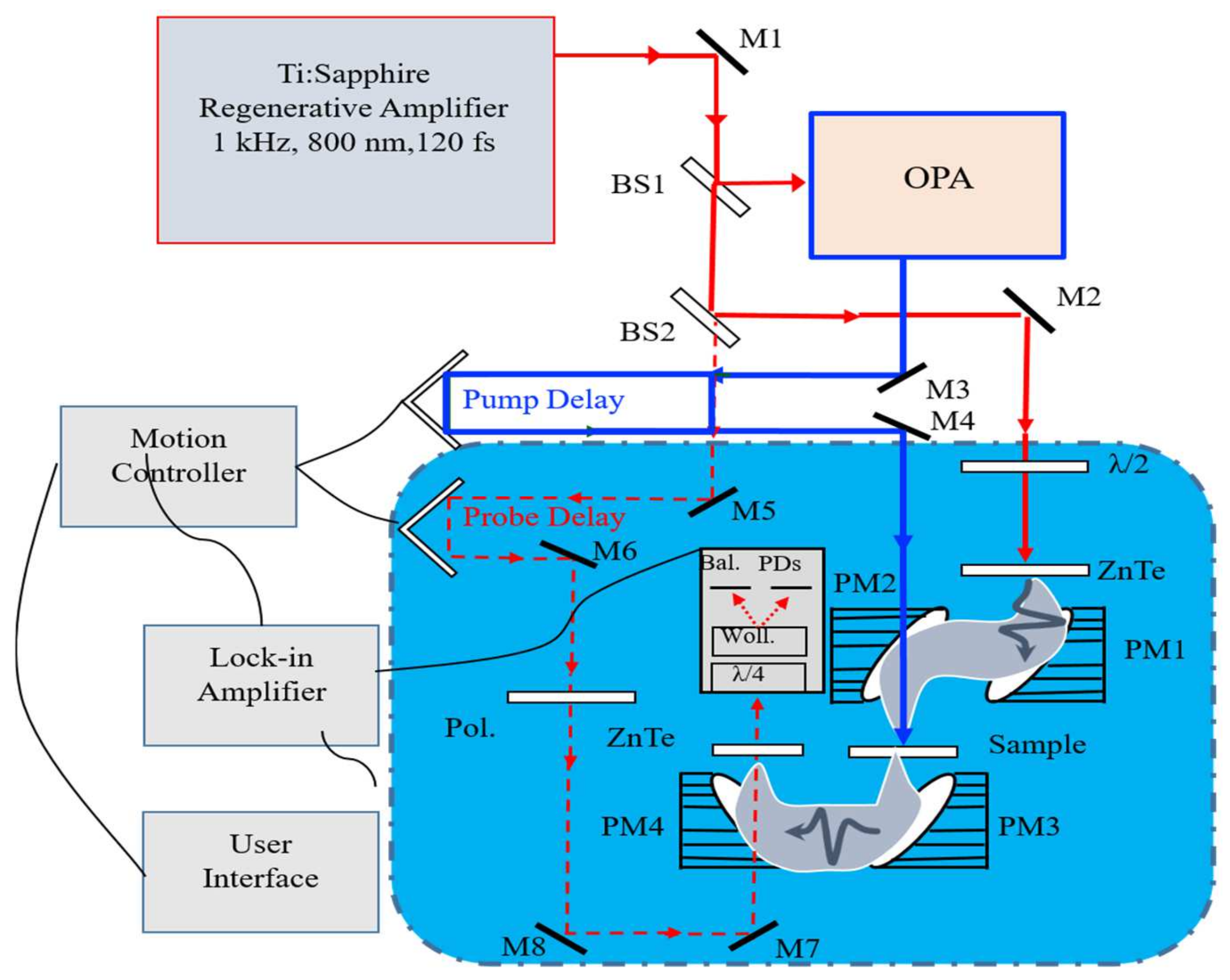
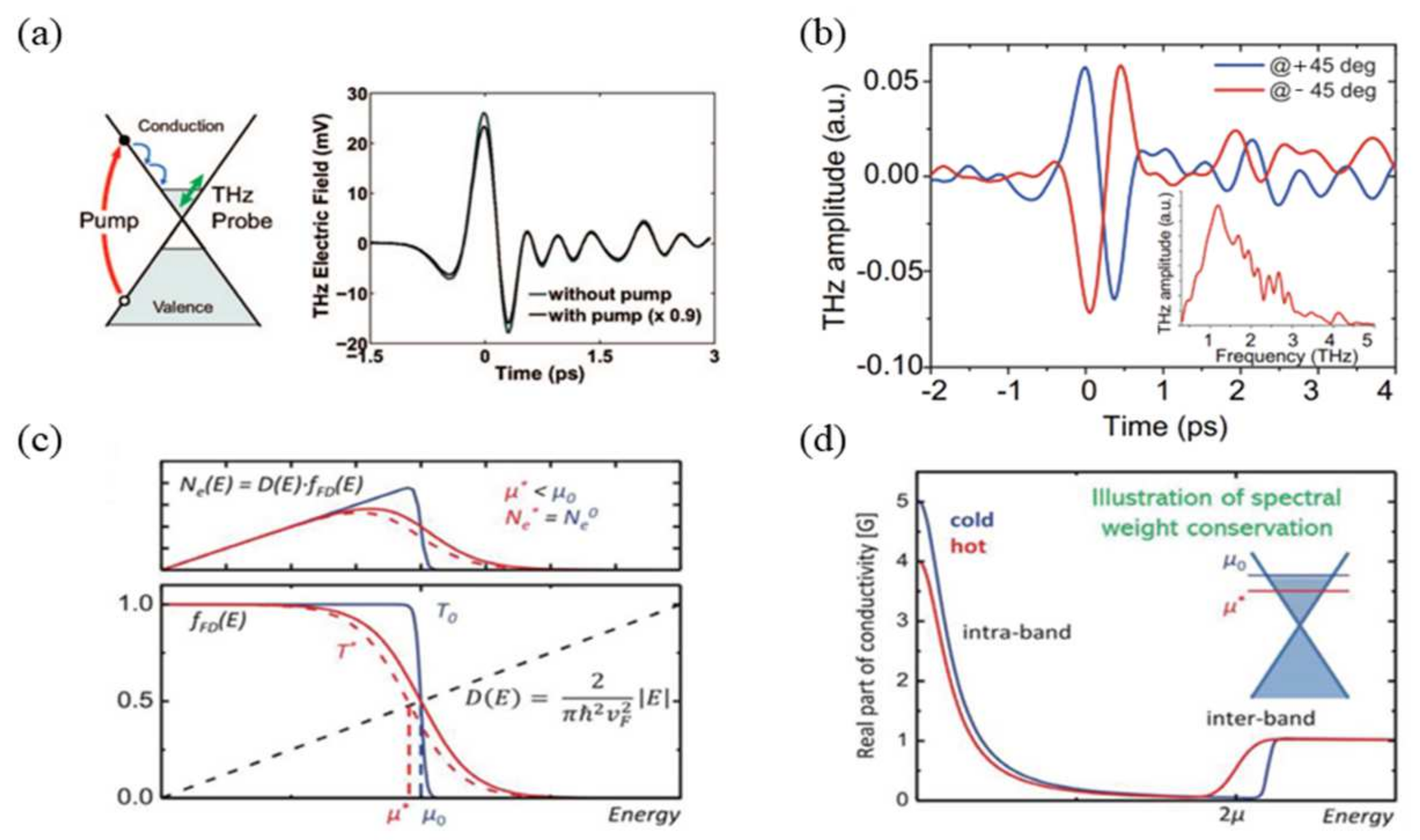
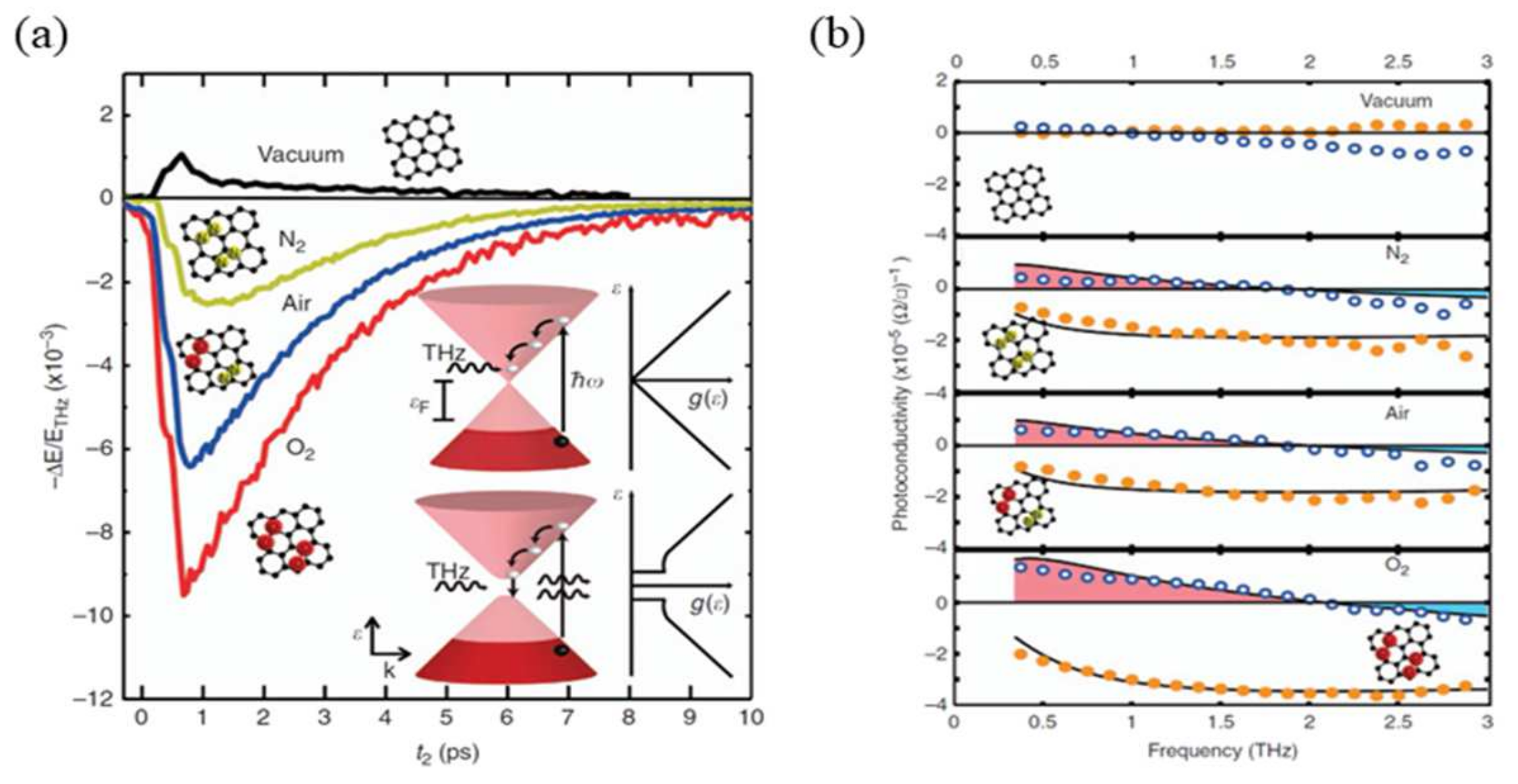
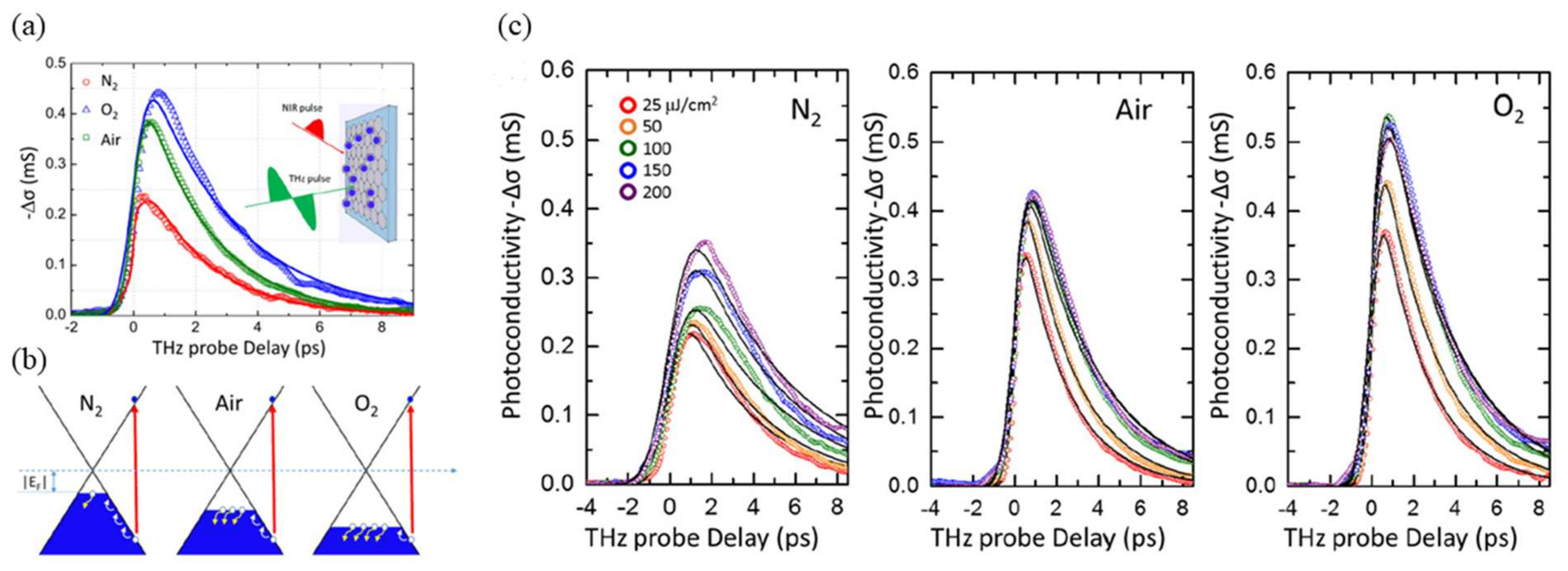

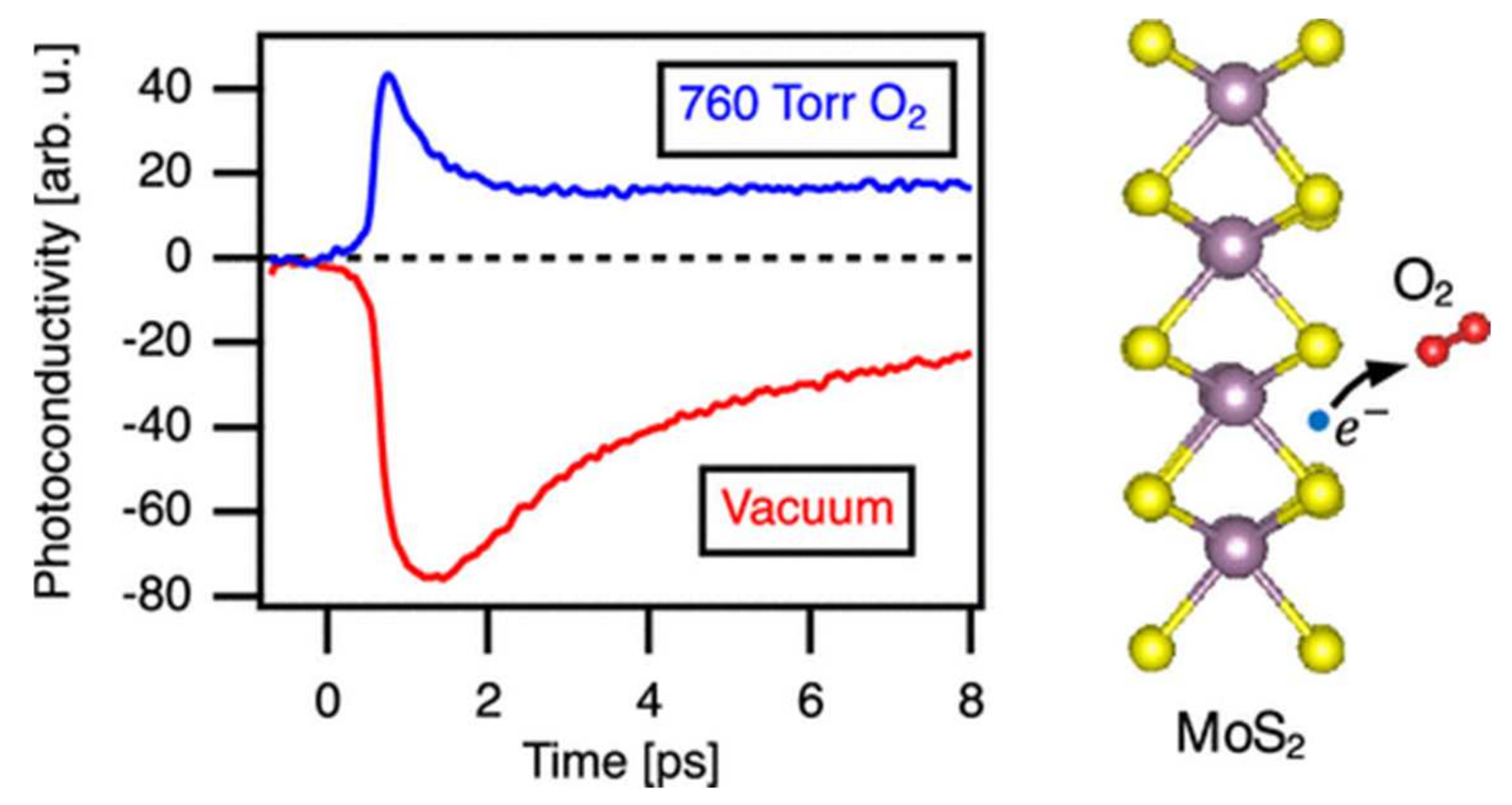





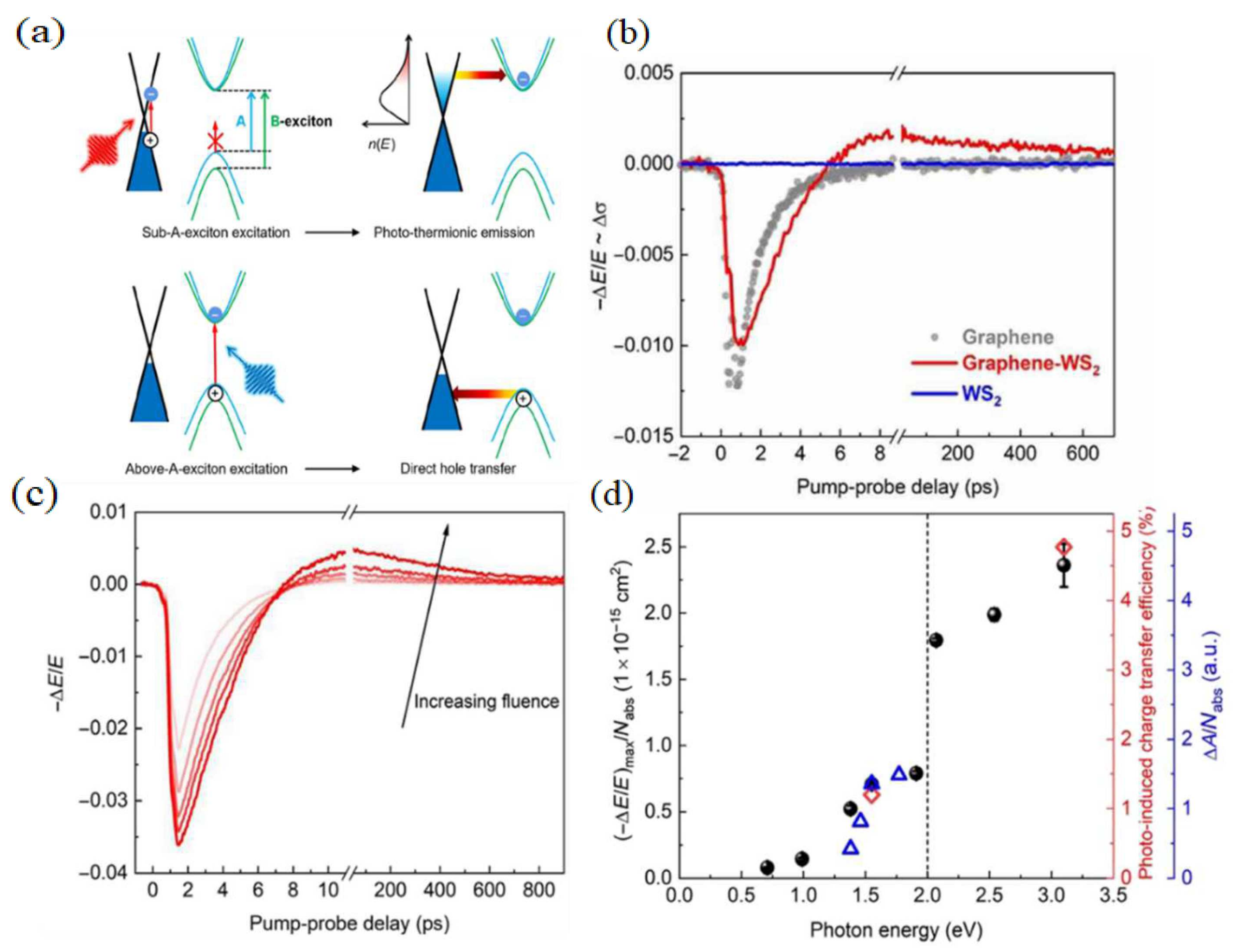
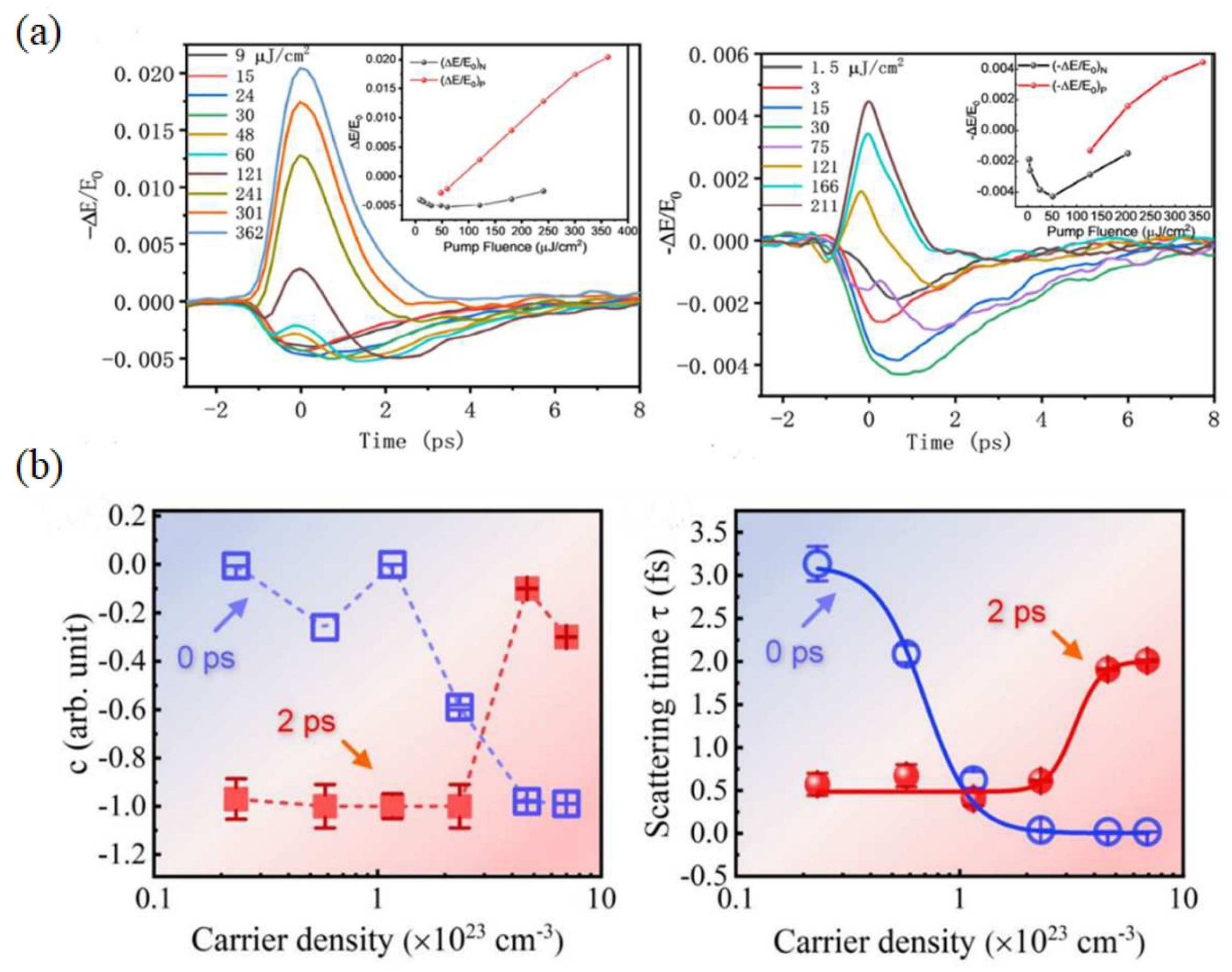

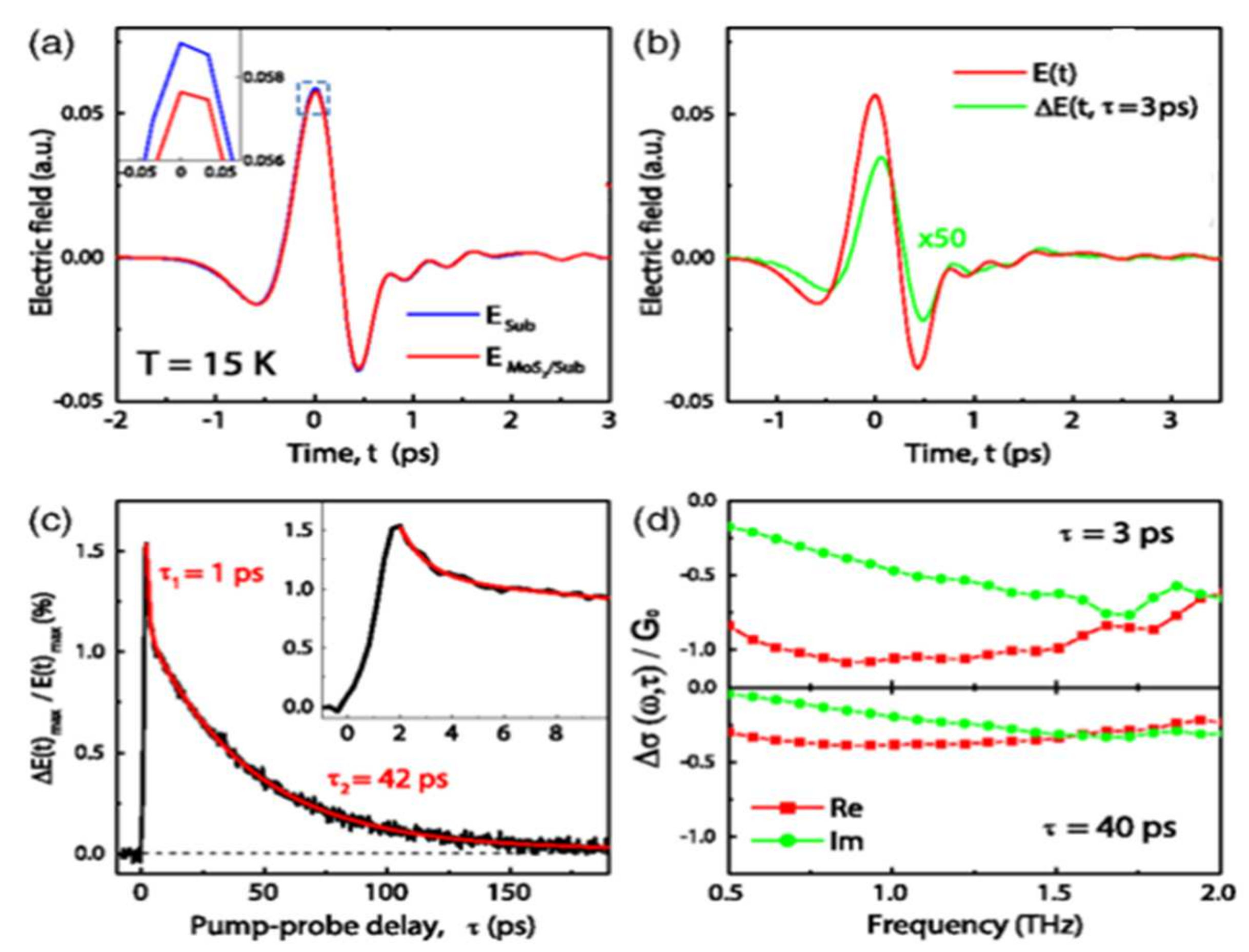
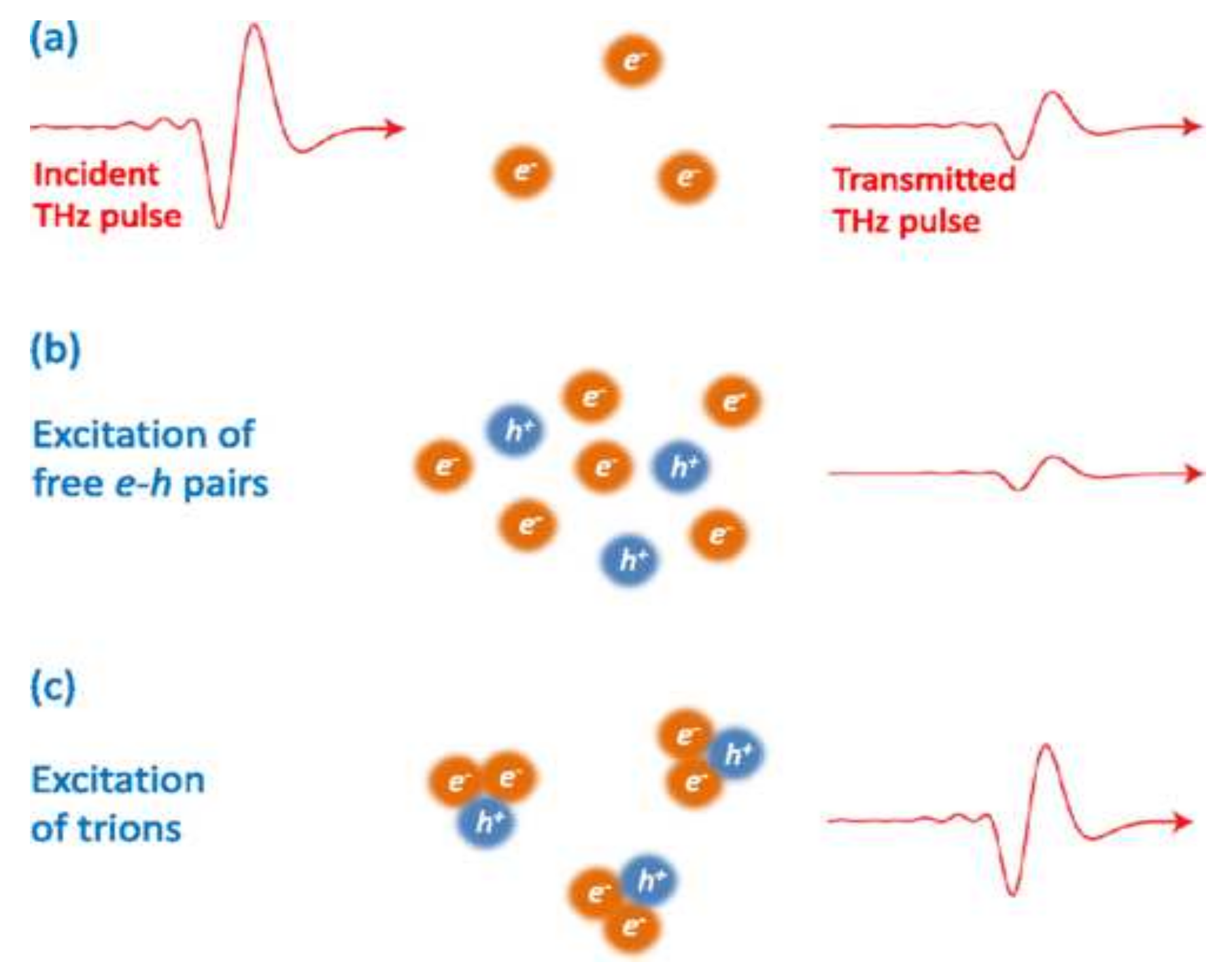
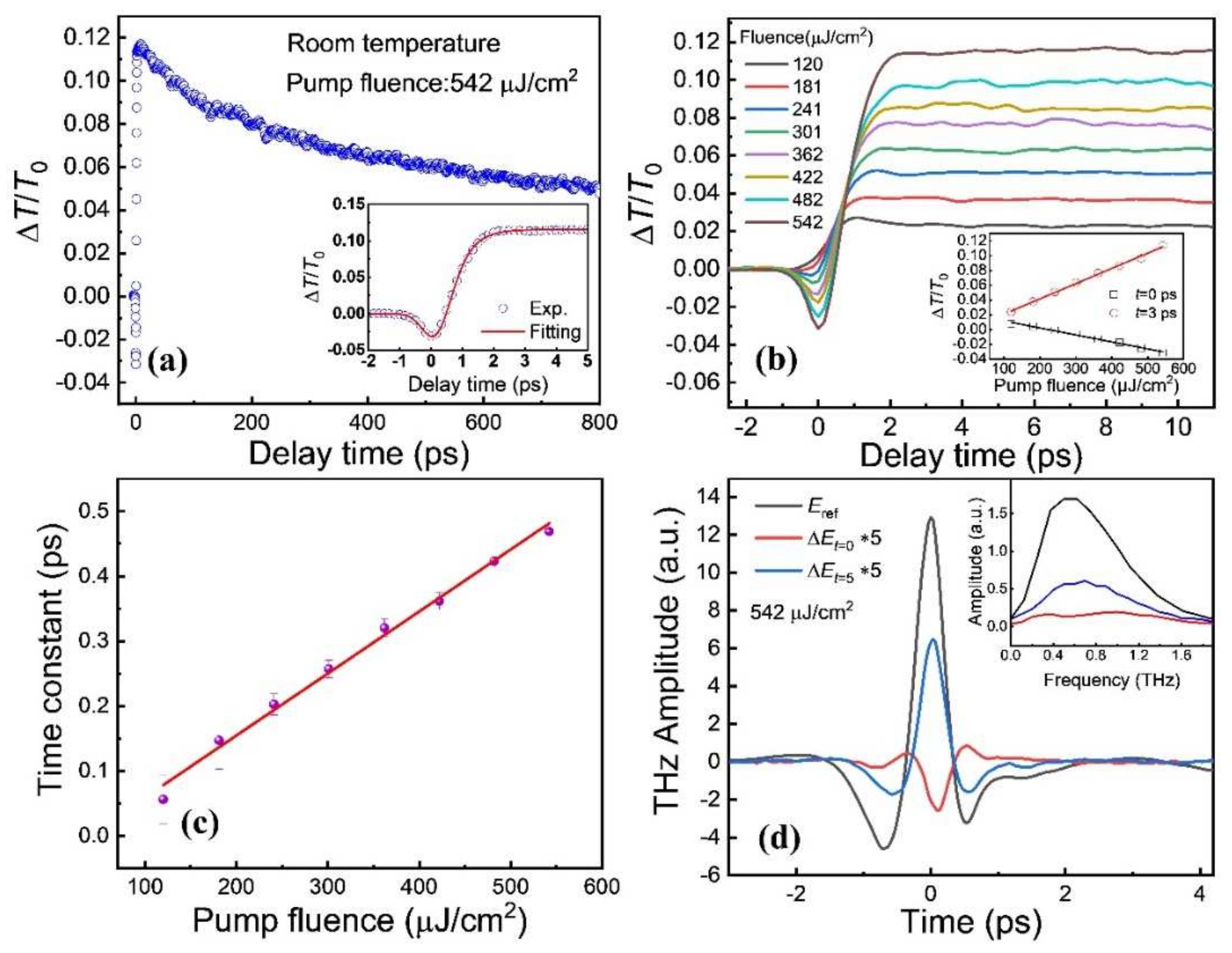

| Time-Resolved Technique | Time Resolution | Spectra Range | Applicable Systems |
|---|---|---|---|
| OPTP | ~500 fs | 0.2–10 THz | Semiconducting, semimetal, and metallic systems |
| TA | ~100 fs | Ultraviolet–Visible–Infrared | Exciton, plasmon, and optical phonon |
| TES | ~100 fs | 0.2–10 THz | Semiconducting, semimetal, and metallic systems |
Disclaimer/Publisher’s Note: The statements, opinions and data contained in all publications are solely those of the individual author(s) and contributor(s) and not of MDPI and/or the editor(s). MDPI and/or the editor(s) disclaim responsibility for any injury to people or property resulting from any ideas, methods, instructions or products referred to in the content. |
© 2023 by the authors. Licensee MDPI, Basel, Switzerland. This article is an open access article distributed under the terms and conditions of the Creative Commons Attribution (CC BY) license (https://creativecommons.org/licenses/by/4.0/).
Share and Cite
Xing, X.; Zhang, Z.; Ma, G. Regulating Terahertz Photoconductivity in Two-Dimensional Materials. Photonics 2023, 10, 810. https://doi.org/10.3390/photonics10070810
Xing X, Zhang Z, Ma G. Regulating Terahertz Photoconductivity in Two-Dimensional Materials. Photonics. 2023; 10(7):810. https://doi.org/10.3390/photonics10070810
Chicago/Turabian StyleXing, Xiao, Zeyu Zhang, and Guohong Ma. 2023. "Regulating Terahertz Photoconductivity in Two-Dimensional Materials" Photonics 10, no. 7: 810. https://doi.org/10.3390/photonics10070810
APA StyleXing, X., Zhang, Z., & Ma, G. (2023). Regulating Terahertz Photoconductivity in Two-Dimensional Materials. Photonics, 10(7), 810. https://doi.org/10.3390/photonics10070810





